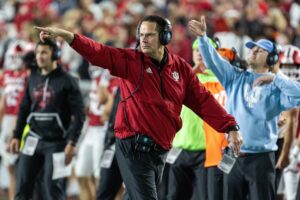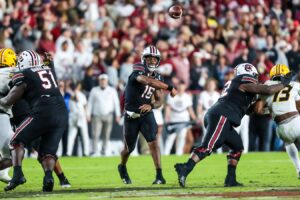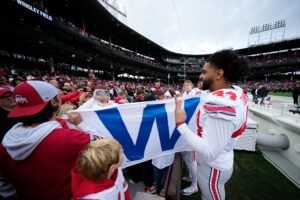Michigan 2018 Recruiting: Success or Failure?
With the second signing day over, it is time for teams to evaluate where they stand. Michigan fans experienced a shock following this year’s National Signing Day. Jim Harbaugh’s staff corralled top ten recruiting classes in both 2017 and 2016. This year, the Wolverines tumbled all the way down to 21st nationally and 3rd in the Big Ten. Unlike Ohio State and Penn State, both of whom handily won their match-ups against Michigan in 2017, the Wolverines signed zero 5-star recruits. However, while national signing day may have disappointed some, thanks to commits that signed back in December the class remains strong overall.
Wolverine Poaching
Weeks before the final of two signing days, Michigan ran into trouble. Offensive line coach, Greg Frey, accepted an offer to return to his alma mater, Florida State. Unfortunately for Michigan fans, Frey was not only a promising coach but also a talented recruiter. The Wolverines also fought off a serious effort by Nick Saban and Alabama to poach linebackers coach Christ Patridge. He was instrumental in recruiting a number of up and coming Wolverines, including Rashan Gary. Ultimately, Patridge signed a two-year contract that increased his pay and gave him the title of recruiting coordinator. Had Patridge also left Michigan, the potential to fallout of the top 30 would have been real.
Michigan’s relative low overall ranking is in part due to two key flips. 4-star center Emil Ekiyor of Indianapolis Cathedral High School was the first commit to jump ship back in October. Ekiyor decommitted from the Wolverines to join Alabama’s Crimson Tide. The second decommittment came on National Signing Day. Long-time Michigan commit Otis Reese, a 4-star linebacker from Georgia, flipped to in-state Georgia. Reese is ranked 87th overall and would have been Michigan’s highest ranked recruit.
The Wolverines also lost two recruiting battles to archrival Ohio State. 4-star defensive tackle Tyler Friday the number two ranked player from New Jersey, officially signed with the Buckeyes. Urban Meyer and the Buckeyes were also able to sign Nicholas Petit-Frere of Tampa, Florida. The top-rated offensive tackle chose Ohio State from a top five that included Michigan. Both losses to the school down south are particularly troublesome for the Wolverines.
Class Strengths
However, the class is still strong. The secondary is one place that stocked for years to come thanks to the Class of 2018. Five of Michigan’s 19 recruits are defensive backs. Including, interestingly, the Green Twins from Desoto, Texas, both three-star recruits. German Green might have received a higher grade, boosting Michigan’s overall ranking, had he not suffered an ACL injury his sophomore year. These new recruits, couple with the fact few members of the secondary left this season suggest coordinator Don Brown should be able to field a top five defense.
The Wolverines’ best signing of the class came earlier this year when quarterback Joe Milton of Orlando, Florida committed and early enrolled. A pro-style quarterback with a cannon arm, many believe Milton will fit perfectly in Harbaugh’s system. Certainly he will provide the coaching staff with more decisions under center. With Wilton Speight’s departure, disastrous quarterback play in the Outback Bowl, and heralded transfer Shea Patterson’s 2018 eligibility in question, flexibility at the quarterback position is key.
Interesting for college football nerds, Michigan signed their European high schooler to a scholarship. Julius Welschof, a German four-star defensive end, signed to join the Wolverines this fall. Michigan beat out Georgia Tech to sign the 28th overall defensive end.
Big Picture
It’s hard not to look at mere seven 4-star recruits and not be disappointed. Especially when the Wolverines had their sights on four additional herald recruits. However, when one steps back and studies the big picture, two important points must be made. First, it is difficult to hit a home run every year. Nearly a third of the top fifteen teams five years ago are not there this year. And the order of the remaining two-thirds is nearly flipped. This class is far from a death sentence for Michigan. An improvement in the class of 2019 will largely make this year’s concerns a moot point.
Secondly, Michigan remains in ranked 7th when teams in the blue chip ratio (the number of 4- and 5-star commits compared to 3-star and below commits on a team’s roster). The teams ranked ahead of them are the who’s who of college football blue bloods (in order: Alabama, Ohio State, LSU, FSU, Georgia, and USC). This is certainly good company to keep and is a much better barometer of long-term talent. Michigan’s 2017 and 2016 classes, both top ten, are going into this season well established. Again, if Harbaugh and company can translate that into on the field success, this season’s ranking will seem an anomaly.






